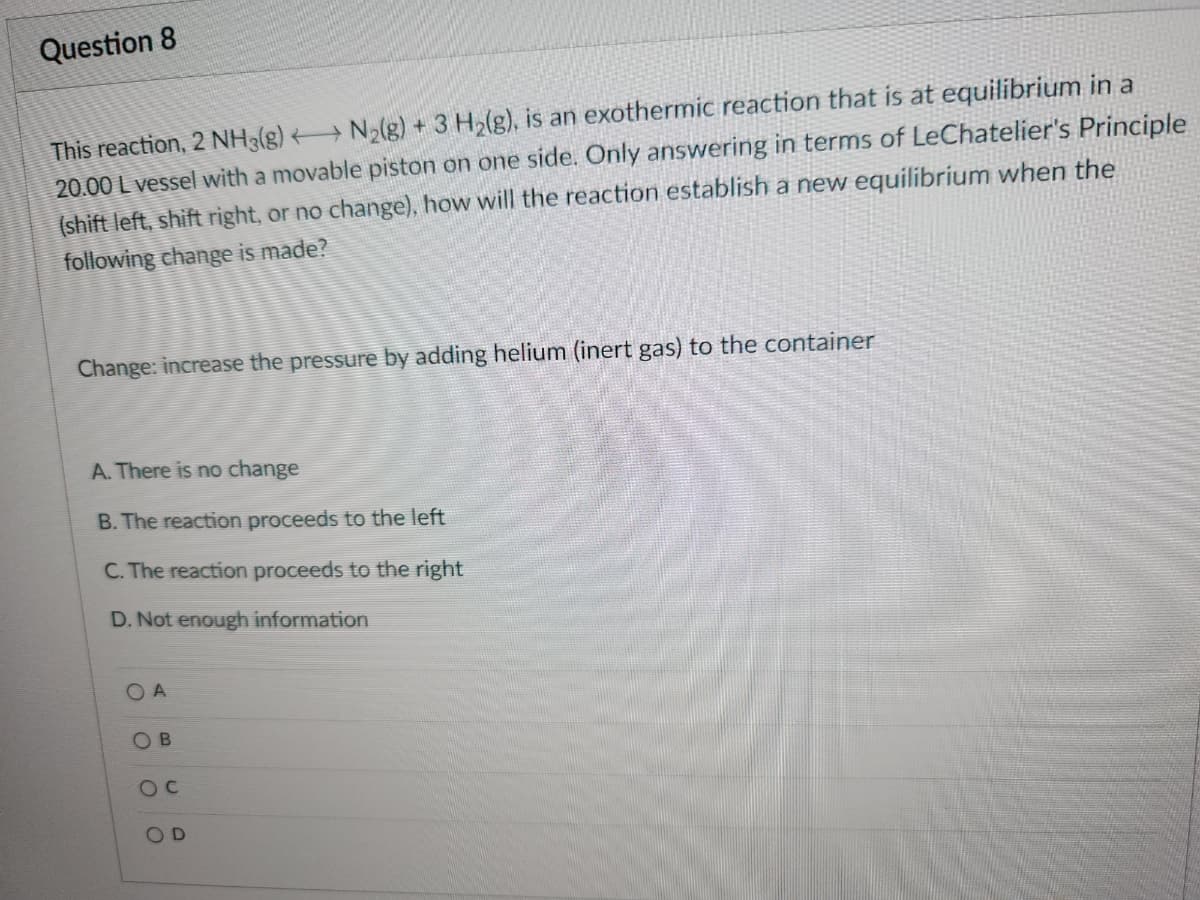Question 8 This reaction, 2 NH3(g) N₂(g) + 3 H₂(g), is an exothermic reaction that is at equilibrium in a 20.00 L vessel with a movable piston on one side. Only answering in terms of LeChatelier's Principle (shift left, shift right, or no change), how will the reaction establish a new equilibrium when the following change is made? Change: increase the pressure by adding helium (inert gas) to the container A. There is no change B. The reaction proceeds to the left C. The reaction proceeds to the right D. Not enough information OA OB OC OD
Question 8 This reaction, 2 NH3(g) N₂(g) + 3 H₂(g), is an exothermic reaction that is at equilibrium in a 20.00 L vessel with a movable piston on one side. Only answering in terms of LeChatelier's Principle (shift left, shift right, or no change), how will the reaction establish a new equilibrium when the following change is made? Change: increase the pressure by adding helium (inert gas) to the container A. There is no change B. The reaction proceeds to the left C. The reaction proceeds to the right D. Not enough information OA OB OC OD
Chemistry by OpenStax (2015-05-04)
1st Edition
ISBN:9781938168390
Author:Klaus Theopold, Richard H Langley, Paul Flowers, William R. Robinson, Mark Blaser
Publisher:Klaus Theopold, Richard H Langley, Paul Flowers, William R. Robinson, Mark Blaser
Chapter13: Fundamental Equilibrium Concepts
Section: Chapter Questions
Problem 89E: At 25 C and at 1 atm, the partial pressures in an equilibrium mixture of N2O4 and NO2 are PN2O4=0.70...
Related questions
Question
16.4 Q8

Transcribed Image Text:Question 8
This reaction, 2 NH3(g) N₂(g) + 3 H₂(g), is an exothermic reaction that is at equilibrium in a
20.00 L vessel with a movable piston on one side. Only answering in terms of LeChatelier's Principle
(shift left, shift right, or no change), how will the reaction establish a new equilibrium when the
following change is made?
Change: increase the pressure by adding helium (inert gas) to the container
A. There is no change
B. The reaction proceeds to the left
C. The reaction proceeds to the right
D. Not enough information
OA
OB
OC
OD
Expert Solution
This question has been solved!
Explore an expertly crafted, step-by-step solution for a thorough understanding of key concepts.
This is a popular solution!
Trending now
This is a popular solution!
Step by step
Solved in 2 steps

Knowledge Booster
Learn more about
Need a deep-dive on the concept behind this application? Look no further. Learn more about this topic, chemistry and related others by exploring similar questions and additional content below.Recommended textbooks for you

Chemistry by OpenStax (2015-05-04)
Chemistry
ISBN:
9781938168390
Author:
Klaus Theopold, Richard H Langley, Paul Flowers, William R. Robinson, Mark Blaser
Publisher:
OpenStax

Introductory Chemistry: A Foundation
Chemistry
ISBN:
9781337399425
Author:
Steven S. Zumdahl, Donald J. DeCoste
Publisher:
Cengage Learning

Chemistry
Chemistry
ISBN:
9781305957404
Author:
Steven S. Zumdahl, Susan A. Zumdahl, Donald J. DeCoste
Publisher:
Cengage Learning

Chemistry by OpenStax (2015-05-04)
Chemistry
ISBN:
9781938168390
Author:
Klaus Theopold, Richard H Langley, Paul Flowers, William R. Robinson, Mark Blaser
Publisher:
OpenStax

Introductory Chemistry: A Foundation
Chemistry
ISBN:
9781337399425
Author:
Steven S. Zumdahl, Donald J. DeCoste
Publisher:
Cengage Learning

Chemistry
Chemistry
ISBN:
9781305957404
Author:
Steven S. Zumdahl, Susan A. Zumdahl, Donald J. DeCoste
Publisher:
Cengage Learning

Chemistry: An Atoms First Approach
Chemistry
ISBN:
9781305079243
Author:
Steven S. Zumdahl, Susan A. Zumdahl
Publisher:
Cengage Learning


Chemistry: Principles and Reactions
Chemistry
ISBN:
9781305079373
Author:
William L. Masterton, Cecile N. Hurley
Publisher:
Cengage Learning